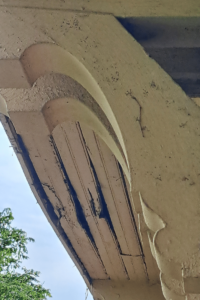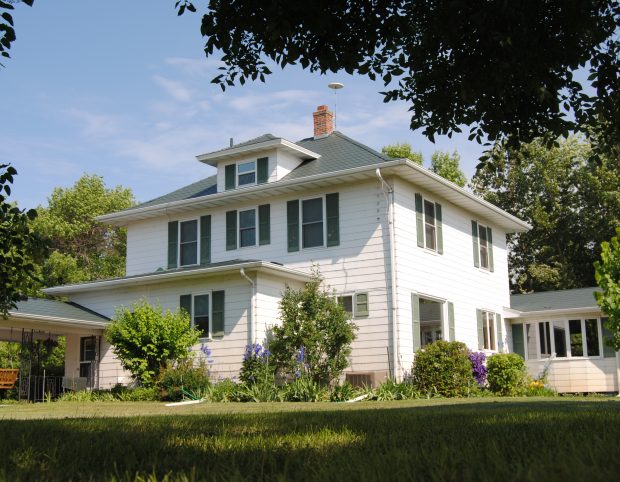When it comes to roofing, there are several components that play a crucial role in aesthetics and functionality. One such component that often goes unnoticed but is integral to the overall structure is the soffit. Keep reading to learn about the soffit. We’ll answer questions about its purpose, differences from other roof components, maintenance tips, and more.
What Is the Purpose of a Soffit?
The soffit is the underside of the roof overhang and it connects the roof overhang with the side of the building. There are two primary functions: to provide ventilation for the attic or roof space and to protect the rafters from the elements. Properly installed soffit allows air to circulate through the attic and prevents moisture buildup that can lead to mold and structural damage.
What Is the Difference Between a Soffit and an Eave?
The terms are sometimes used interchangeably, but there is a difference between the soffit and eave. The eave is the lower edge of the roof that overhangs the wall, including the fascia board and the soffit underneath it. The soffit specifically refers to the horizontal underside of the eave.
Do You Need a Soffit Vent?
Incorporating soffit vents is crucial for maintaining proper attic ventilation. Soffit vents allow fresh air to enter the attic from the underside of the roof, while hot, moist air escapes through vents located higher up. This equal airflow helps regulate temperature and humidity, extending the lifespan of the roof and preventing issues like ice dams in colder climates.
Soffit vs. Fascia on a Roof
While the soffit is located underneath the eave, the fascia is the vertical finishing edge connected to the ends of the rafters or trusses. The fascia board plays a critical role in protecting the roof structure and supporting the gutters. Together with the soffit, it contributes to the overall aesthetics and functionality of the roofline.
How Long Should Soffit Last?
The longevity of the soffit largely depends on the material used and local weather conditions. High-quality materials like steel can last upwards of 20-30 years with proper maintenance and occasional inspections for damage or wear.
Signs It’s Time to Replace Your Soffit and Fascia
- Is there visible damage, such as cracks, warping, or discoloration?
- Are there any signs of water damage in the form of moisture or mold?
- Is there evidence of pests nesting in the soffit?
- Do you notice any sagging or loose sections?
If you notice any of these signs, it’s possible you need your soffit and fascia replaced.

Sagging, warped, and cracked wooden soffit that needs to be replaced
Can You Replace Soffit Without Replacing Fascia
It’s technically possible to replace the soffit without replacing the fascia. However, not addressing the fascia can lead to aesthetic inconsistencies and potential functional issues. It’s generally recommended to replace both components simultaneously to ensure uniformity and structural integrity.
Best Materials for Soffit and Fascia
Vinyl
Vinyl is always a popular choice for homeowners looking for an affordable and low-maintenance solution. It doesn’t require painting, is resistant to moisture and pests, and can come in various colors. However, vinyl can become brittle and crack in extreme temperatures and it can fade over time with prolonged exposure to sunlight. Additionally vinyl is made from PVC which isn’t as environmentally friendly as other materials.
Aluminum
Aluminum soffit and fascia are lightweight, which makes them easy to install and reduces labor costs. Aluminum is also naturally resistant to corrosion, which is especially beneficial for homes in humid or coastal areas. It offers aesthetic versatility, because it comes in various colors and can be painted. However, aluminum is more prone to denting and bending, particularly in areas with high wind or hail, and it doesn’t have the same level of strength as steel.
Wood
Wood soffit and fascia offer a classic, natural look that enhances the charm of traditional homes. Wood is highly customizable, allowing for painting or staining in any color to match your home’s aesthetic. However, wood requires regular maintenance, including painting, sealing, and inspections, to prevent rot, warping, and pest damage. It’s also more expensive than other materials and is vulnerable to moisture, which can lead to mold and structural issues.
Steel
Steel is the standout material for soffit and fascia due to its unmatched durability and strength. It’s capable of withstanding extreme weather conditions, including heavy snow, hail, and high winds. It’s also low maintenance, resists rust, fading, and warping over time, and can last 20-30 years or more with proper installation and maintenance. Additionally, steel is often made from recycled materials, which makes it cost-effective in the long run. However, in areas with salty air or high humidity, it could be more prone to corrosion if the protective coating is damaged.
Can I Install New Soffit Myself?
Installing soffit requires careful attention to detail and knowledge of proper ventilation techniques. While DIY installation is possible for those with experience in construction, it’s often advisable to consult with roofing professionals to ensure correct installation and adherence to local building codes.
Fremont Steel Soffit and Fascia Installation
At ABC of Nebraska, we specialize in steel soffit and fascia installation. Our team of experienced installers ensures quality craftsmanship and attention to detail, ensuring your roofing components perform optimally for years to come. Trust ABC of Nebraska for reliable products and expert installation services. Contact us today to learn more about how steel soffit and fascia can elevate your home’s curb appeal and functionality.




